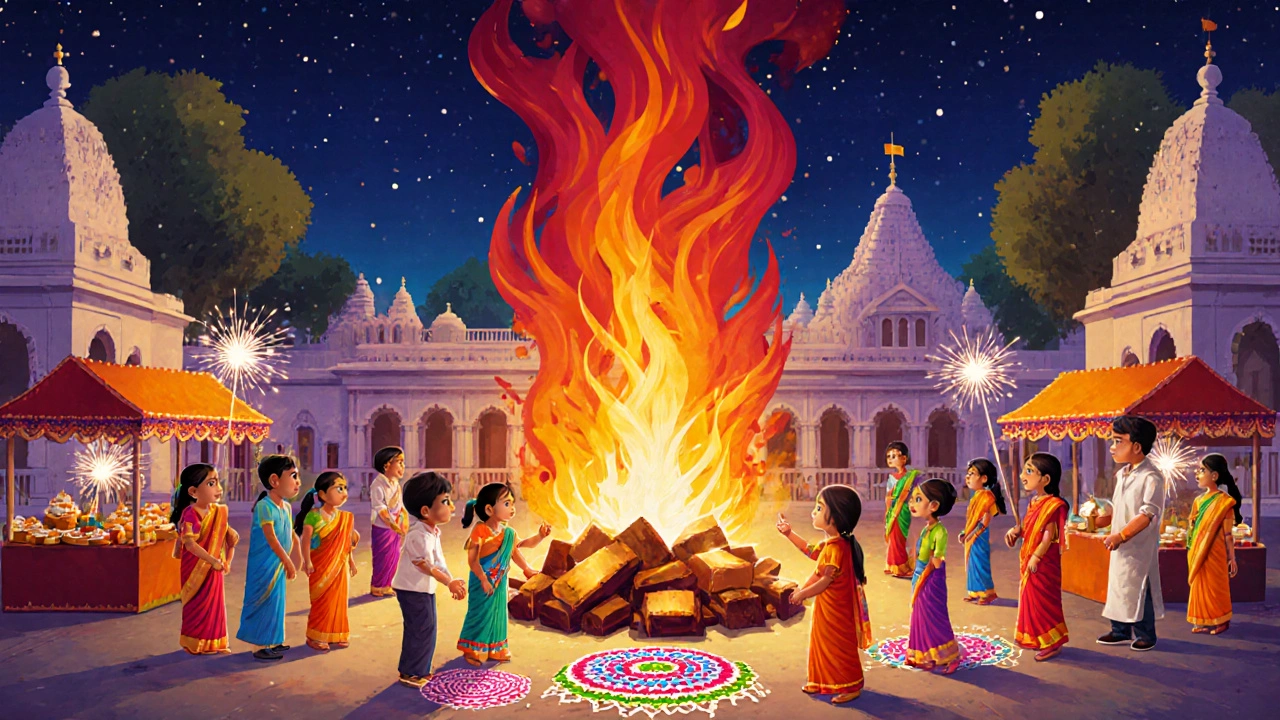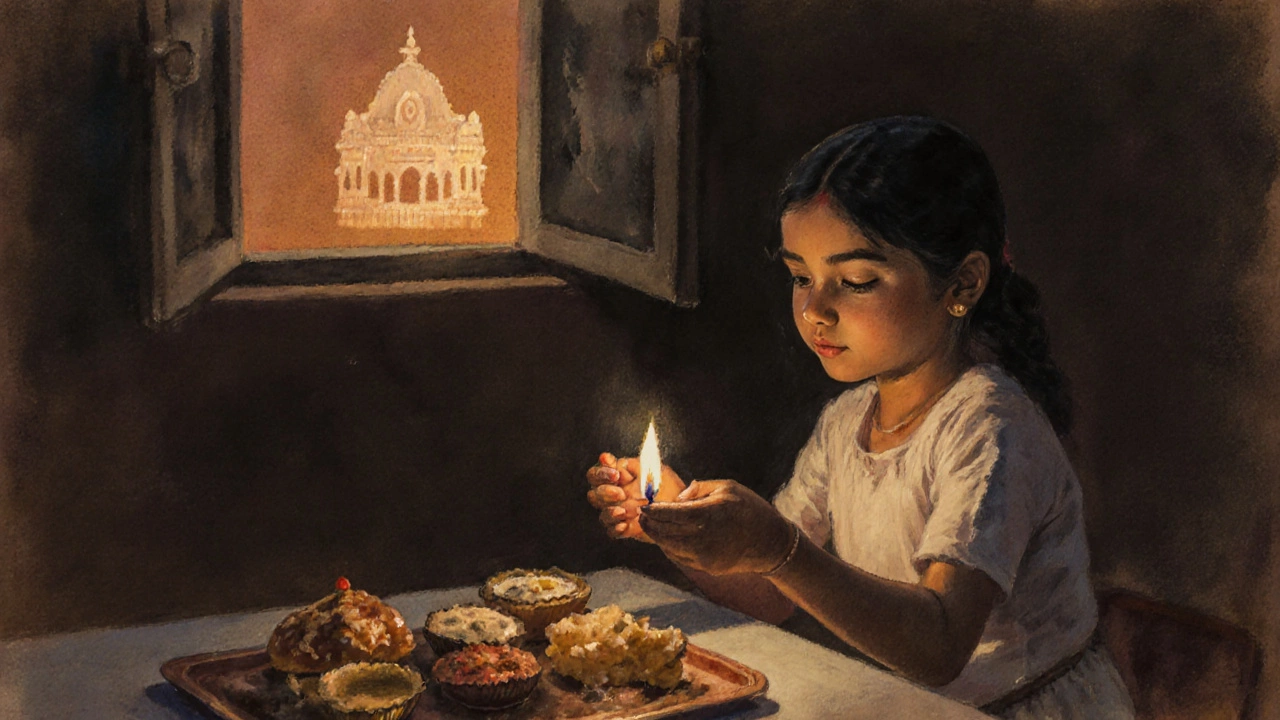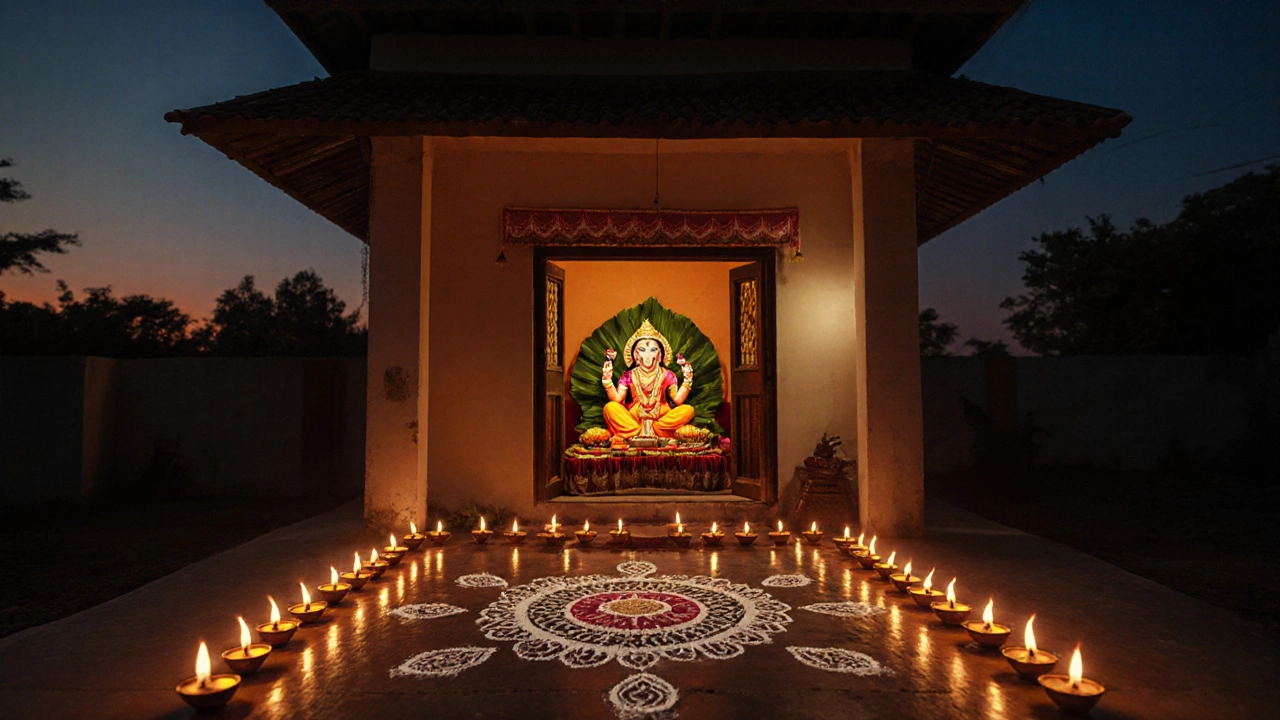Tamil Diwali vs. North Indian Diwali Comparison Tool
- Date: New moon of Kartik (October–November)
- Deities: Lakshmi & Ganesha
- Ritual: Lighting earthen lamps (diyas) at dusk
- Sweets: Ladoo, barfi, mithai
- Activities: Fireworks, street fairs, melas
- Date: Full moon of Karthigai (November–December)
- Deities: Lakshmi, Ganesha & local village deities
- Ritual: Lighting massive Deepam bonfire and multiple kandils
- Sweets: Adhirasam, payasam, murukku
- Activities: Deepam lighting at temples, kolam competitions
Lighting Ceremony: While North Indians light diyas at dusk, Tamils light a large bonfire (Deepam) along with smaller kandils.
Timing: Tamil Diwali begins a day earlier than North Indian Diwali due to the Karthigai Deepam tradition.
Community Activities: Tamil celebrations often involve kolam competitions and temple-based Deepam lighting, whereas North India features street fairs and fireworks.
Celebration Highlights:
Quick Takeaways
- Tamils do celebrate Diwali, but the festival blends with the local Karthigai Deepam tradition.
- Key rituals include lighting oil lamps (kandil), worshipping Lakshmi and Ganesha, and creating kolam designs.
- Celebrations in Tamil Nadu start a day earlier than most of India and often last for three days.
- In the diaspora, especially places like Brisbane, Tamil families combine traditional Tamil customs with mainstream Diwali activities.
- Understanding regional nuances helps avoid common misconceptions about Tamil Diwali practices.
When you hear the word Diwali, the first image that comes to mind is probably fireworks, sweets, and rows of lit oil lamps across North Indian streets. But does this glittering festival have a place in Tamil life? Absolutely. Tamil communities across the world observe Diwali, but their version carries distinct flavors shaped by centuries‑old regional customs.
What is Diwali?
Diwali is a five‑day Hindu festival that marks the triumph of light over darkness and good over evil. Traditionally it commemorates Lord Rama’s return to Ayodhya after a 14‑year exile, the victory of Lord Krishna over the demon Narakasura, and the worship of the goddess Lakshmi, who brings wealth and prosperity. While the core idea stays the same, how each Indian state celebrates can differ dramatically.
Who are the Tamils?
In the cultural sense, Tamil people are an ethnic group native to the southern Indian state of Tamil Nadu and the union territory of Puducherry, as well as large diaspora communities in Sri Lanka, Malaysia, Singapore, and countries like Australia and Canada. Their language, Tamil, is one of the world's oldest living languages, and their cultural calendar is packed with unique festivals, temple arts, and culinary traditions.

How Tamils Celebrate Diwali
In Tamil Nadu, the Diwali period overlaps with a regional festival called Karthigai Deepam. While North India lights lamps on the night of the new moon in the month of Kartik, Tamil households typically begin celebrations a day earlier, during the full moon of the Tamil month of Karthigai (usually late November or early December). The result is a hybrid celebration that honors both pan‑Indian Diwali themes and local traditions.
Key rituals observed by Tamils include:
- Lighting oil lamps (kandil) and giant bonfires: Families line the front of their homes with rows of small oil lamps called kandils. On the main night, a large fire (Deepam) is lit in temples and public spaces, symbolizing the victory of light.
- Early morning puja to Lakshmi and Ganesha: A special Lakshmi idol is placed on a raised platform, surrounded by fresh mango leaves and rice. Ganesha is also worshipped to remove obstacles before the new financial year begins.
- Kolam (rangoli) designs: Using rice flour, women draw intricate geometric patterns at the entrance of the house. These kolams are meant to invite prosperity and keep pests away.
- Cooking festive sweets: Traditional treats like adhirasam, payasam, and murukku are prepared in large batches and shared with neighbors.
- Fireworks and crackers: Though more restrained than in metropolitan Delhi, Tamil families enjoy sparklers and small firecrackers, especially in urban areas.
- Charity and community service: Many temples organize free meals (annadanam) and distribute clothing or food packets to the underprivileged.
In Tamil diaspora hubs like Brisbane, families often gather at local Hindu temples that host multi‑cultural Diwali programs. The events blend Tamil-specific rites-like the lighting of a towering Deepam replica-with broader Indian performances such as Bollywood dances and classical Carnatic music.
North Indian Diwali vs. Tamil Nadu Diwali: A Quick Comparison
| Aspect | North India (Typical) | Tamil Nadu (Typical) |
|---|---|---|
| Primary date | New moon of Kartik (Oct‑Nov) | Full moon of Karthigai (Nov‑Dec) |
| Key deity worshipped | Lakshmi & Ganesha | Lakshmi, Ganesha & local village deities |
| Iconic ritual | Lighting earthen lamps (diyas) at dusk | Lighting massive Deepam bonfire and multiple kandils |
| Traditional sweets | Ladoo, barfi, mithai | Adhirasam, payasam, murukku |
| Public festivities | Fireworks, street fairs, melas | Deepam lighting at temples, kolam competitions |
Common Misconceptions
Many people assume that Tamils only celebrate Karthigai Deepam and skip Diwali entirely. In reality, most Tamil Hindus observe both, treating the Deepam fire as an extension of Diwali’s light‑theme. Another myth is that Tamils avoid fireworks. While some temples discourage loud crackers for safety, many families still enjoy a modest display, especially in regions where local regulations permit it.

Experiencing Tamil Diwali in the Diaspora
If you live in a multicultural city like Brisbane, attending a Tamil temple’s Diwali program is the easiest way to glimpse authentic customs. Look for events hosted by the Tamil Sangam or local Hindu societies. Expect a blend of:
- Traditional bhajans in Tamil, often led by a Carnatic vocalist.
- Live demonstration of kolam drawing, where children use colored rice flour.
- Food stalls serving South Indian sweets alongside North Indian treats.
- A towering Deepam replica, lit at dusk, creating a spectacular backdrop for photographs.
These gatherings also provide a chance to meet fellow Tamils, exchange recipes, and learn about regional variations-from the elaborate fireworks of Chennai to the more modest ceremonies of rural Tamil Nadu.
Practical Tips for First‑Time Visitors
- Dress modestly: Traditional shalwar‑kameez or simple saris are appreciated.
- Bring a small offering: Fresh fruit, sweets, or a packet of rice can be placed on the altar.
- Participate in the lamp lighting: Even a simple act of lighting a kandil is considered auspicious.
- Respect noise limits: Many Australian councils enforce quiet hours; opt for sparklers instead of loud firecrackers.
- Try the food: Don’t miss adhirasam-a deep‑fried jaggery sweet that’s a Diwali staple in Tamil homes.
Frequently Asked Questions
Do all Tamil Hindus celebrate Diwali?
Most Tamil Hindus observe Diwali, though the intensity of the celebration can vary by family tradition, region, and personal belief. Those who follow the Saiva‑Shakta sect may focus more on worshipping deities like Murugan alongside Lakshmi.
How does Karthigai Deepam differ from Diwali?
Karthigai Deepam is traditionally a harvest‑related festival that centers on lighting a single massive fire (Deepam) on a hill or temple courtyard. Diwali, on the other hand, spans five days and involves multiple rituals, including puja, sweets, and fireworks. In Tamil Nadu, the two festivals often merge, with the Deepam fire becoming part of the Diwali celebration.
What foods are must‑have during Tamil Diwali?
Key sweets include adhirasam (jaggery‑flavoured doughnut), payasam (sweet rice pudding), and murukku (crispy rice snack). Savoury items like vadai and paniyaram are also common.
Can I celebrate Tamil Diwali without a temple?
Absolutely. Home‑based puja, lighting kandils, preparing traditional dishes, and creating kolams are all meaningful ways to observe the festival. Many families also organize neighborhood gatherings to share sweets and light lamps together.
When is the best time to visit a Tamil temple for Diwali?
The main ceremony usually begins at dusk on the day of the full moon in the Tamil month of Karthigai. Arriving an hour early lets you join the kolam‑drawing session and witness the lighting of the Deepam.
So, Diwali in Tamil culture is a vibrant blend of ancient North Indian lore and distinct South Indian customs. Whether you’re strolling through a temple in Chennai, joining a community event in Brisbane, or lighting a simple kandil at home, the festival’s core message-light triumphs over darkness-remains the same.
